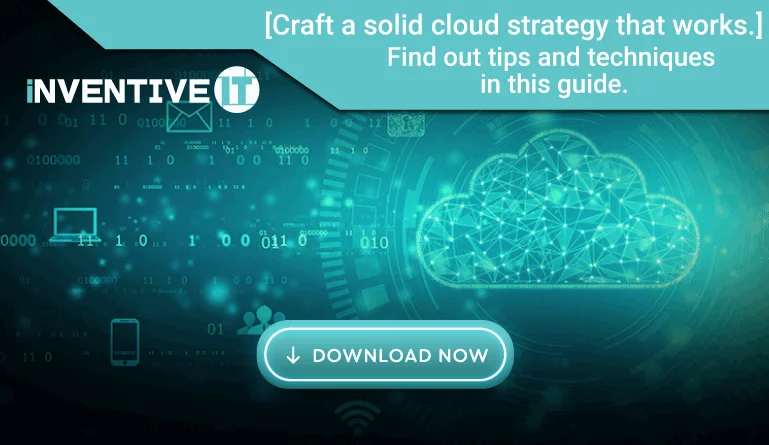How do you engage high-value target accounts with the right content at the right time so that they ultimately convert?
The answer is found in account-based marketing. B2B marketers are implementing this type of strategy and making major investments and seeing boosted revenue from doing so.
According to ITSMA , nearly 85% of B2B marketers who have implemented and measured ROI state that ABM has delivered higher returns than any other marketing method.
That many marketers cannot be wrong.
What is Cloud Computing?
Cloud is a platform that hosts a pool of computing resources over the Internet as a convenient, on-demand utility to be rented on a pay-as-you-go basis. All Clouds are basically virtualized data centers made up of computation and storage resources.
The term Cloud computing services comprises all the services which are hosted over a Cloud. Hence Cloud Computing is the utilization of services such as storage, applications, and servers, over the cloud.
Most organizations go for Cloud services to reduce their investments in infrastructure costs, maintenance costs, and ensuring the availability of resources round the clock. Cloud Computing is a more efficient and cost-effective solution than traditional data centers.
History of Cloud Computing
The Cloud Computing that stands today can be traced back to the 1960s when John McCarthy, Douglas Parkhill explored the idea of providing Computing facilities as a public utility.
But the practical applications of sharing resources were introduced by IBM in the 1970s with the concept of “time-sharing”. At a time when users were restricted to booking time and using computing resources sequentially or ‘Batch Processing’, IBM introduced the RUSH (Remote Users of Shared Hardware). This permitted multiple users to simultaneously use the Computing resources of a single computer through dummy/virtual terminals.
It is considered the birth of Virtualization in Computing. This along with Grid Computing and Utility Computing in the 1990s formed the stepping stones to Cloud Computing. Gradually with the increase in processing power of machines and an explosion in networking bandwidth over the internet, reinforced businesses to utilize these resources on-demand and in a dynamically scalable fashion.
In 1999, Salesforce can be termed as the first successful implementation of Cloud Computing Services for hosting their CRM system.
How does Cloud Computing work?
Consider that you have a server on-site with your Enterprise software and its database. This incurred an initial investment in terms of IT infrastructure and the physical location, and there are gradually growing costs involving maintenance.
To avoid these costs, enterprises turn towards Cloud Computing Service vendors that provide the same or advanced infrastructure as per your specifications on a rental basis.
The regular maintenance and upgrade activities are performed by the vendor and as a business, you just need to manage your application that is hosted on this rented platform.
Further upscaling or downgrading of these utilities are also managed dynamically by the Cloud services provider.
This provides a prominent workload and cost transition for Enterprises and helps them concentrate on their core businesses, while their IT Resources are being managed by an external entity.
Types of Cloud Computing Services
What are the services that can be availed from a Cloud vendor?
Based on the utilities that are procured the Cloud computing services are divided into 3 major categories – Infrastructure as a Services (IaaS), Platform as a Services (PaaS) and Software as a service (SaaS).
-
Infrastructure as a Service
IaaS is where virtualized computing infrastructure is provisioned and managed for businesses by Cloud vendors. The IT resources that are offered in IaaS include storage, servers and networking utilities over the internet.
Major companies that provide IaaS are AWS, Rackspace Open Cloud, IBM Smart Cloud, Microsoft Azure and more.
-
Platform as a Service
PaaS is where coupled with the underlying hardware, the third-party vendor provides middleware, operating systems, and tools required to develop and test applications. This helps you avoid the cost of maintaining, patching or any kind of capacity planning required for your underlying platform.
The common vendors providing PaaS are AWS, Salesforce.com, Microsoft Azure, Oracle Cloud, SAP and OpenShift among others.
-
Software as a Service
As part of SaaS, the third-party vendor provides you with the entire stack to be leased on a pay-as-you-go basis. SaaS provides you the complete freedom to work on the procured software without worrying about how the infrastructure or even how the underlying software is maintained.
The popular vendors of SaaS are Microsoft 365, Zoho, Salesforce, SAP, Google G Suite and more.
Introduction to Serverless Computing
Organizations are gradually moving away from the concept of dedicated or defined hardware or platform towards Serverless Computing. Serverless computing is an upcoming concept provided by Cloud Computing vendors and Containerization is the core element used for Serverless Computing. Containers are capsules that hold the IT Infrastructure related information required by an application to run smoothly.
In the Serverless computing model when you deploy an application over a Cloud, the Cloud services provider analyzes the code and dynamically generates the required resources to run the application effectively. These specifications of the underlying infrastructure are mentioned in the Container in which the application is packaged.
Due to the introduction of serverless computing, the process of how applications are developed and hosted is rapidly changing. The Cloud Computing Service providers are broadening their utilities and allowing organizations to concentrate only on the Application and their customers. This provides organizations with a compelling business reason for gradually migrating to the Cloud.
Types of Cloud Computing Models
The business model based on which the Cloud Computing Services are offered differs majorly on the hosting models that you choose.
-
Public Cloud
A cloud whose resources are shared by multiple customers is known as a public cloud. Each customer that procures the services of a cloud is known as a tenant. A Public Cloud can have multiple tenants sharing the same resources and services.
These tenants only pay for the services that they use similar to our water or electricity usage. They book a fixed amount of space or computational capability or application beforehand and are billed accordingly. Since the infrastructure of a public cloud is shared it is cheaper to use.
-
Private Cloud
In the case of the private cloud, the entire cloud is dedicated to one tenant. As a tenant, you can customize the cloud according to your needs. You can be connected to the Private Cloud by use of either a private LAN or over the internet.
Most enterprise-level applications are hosted on a Private Cloud, where the entire data of an organization is kept secure. This further allows the flexibility to dynamically increase/decrease the utilities as per the business demands, as the SLAs defined for Private Clouds are very stringent. Organizations that have highly sensitive information or mission-critical applications opt for the private cloud.
-
Hybrid Cloud
As the name goes a hybrid cloud is the combination of public and private clouds providing the best of both worlds. With the Hybrid cloud, when any of the resources on the Private cloud are completely occupied and need to be increased, these extra resources are borrowed from the Public Cloud.
This phenomenon is called Cloud Bursting. A Hybrid cloud gives you the flexibility to host a few of your applications on a public cloud and other critical ones on the Private Cloud. This provides you with cost and resource savings according to your needs.
Advantages of Cloud Computing
-
Cost efficiency
This is the most lucrative reason why businesses decide on moving to the cloud. The traditional methods of having in-house servers and buying software licenses can cost companies a lot.
Cloud Services are available on rent, hence cost remarkably lesser reducing the IT expenses of a company. Smaller firms that cannot afford a huge initial investment can leverage the cloud-hosted services and pay only for the specific utilities that they need.
-
Backup and recovery
The architecture of Cloud environments is designed to provide high availability. Hence, they have a preplanned disaster recovery site set up for their Cloud.
The data banks with the cloud service providers facilitate redundancy, that ensures maximum availability of your data. This facilitates the restoration of your data faster compared to traditional Disaster Recovery.
-
Accessibility and Convenience
Since Cloud services are hosted over the internet and can be utilized anytime, anywhere. This provides organizations with improved accessibility and productivity. The services of an enterprise hosted on the cloud can be accessed from across the globe.
-
Unlimited IT Resources
As the resources offered over the cloud can be dynamically extended as per business needs, Cloud makes the extent of these resources seem limitless. Data Storage, Computational Power, Network bandwidth all can be instantly extended in cases of higher workload. In a traditional IT setup, this would require preplanning and buying resources well beforehand.
-
Flexibility and Scalability
Cloud environments provide solutions for befitting enterprises of all sizes. Cloud vendors provide organizations with the flexibility to have their resources partially on a Private and partially on a Public cloud.
Temporarily scaling up resources as and when needed is a pocket-friendly option for SMEs or Startups. Elastic applications that experience high-demand periods can utilize the scalability feature of the cloud to cater to an extended size of users.
( Also Read: 14 Incredible Benefits of Cloud Computing for Businesses )
Disadvantages of Cloud Computing
Cloud Computing Services seem to be a new-age solution that can sustain over the coming years, but it does have its shortcomings.
-
Security
Security is the majorly debated concern that enterprises have while moving their data to the cloud. As you migrate your data and services to an external location beyond your onsite servers, it is considered a potential risk. Since Clouds services are accessible over the internet the information is considered vulnerable to cyber-attacks.
-
Restriction
Choosing the services of a particular vendor limits organization to the proprietary applications hosted by that Cloud Service provider. Application sharing between cloud service providers is limited.
-
Mandatory Internet Connection
In the case of Traditional In-house Hosting, small businesses were not dependent on a connection to the internet for their daily activities. With the use of Cloud services being connected to the internet to utilize enterprise applications is mandatory. Hence a loss of internet connectivity can cause downtime for such businesses.
Common Myths while working with Cloud Services
-
Data is not safe on the Cloud
The security measure of a Cloud depends on the Cloud Service providers that you have opted for. It is advisable to go through their security policies to prevent attacks before UTILIZING their services. SMEs usually cannot afford to invest heavily in security. Cloud provides them with the security features they couldn’t normally afford.
“Because large cloud computing companies have more resources, they are often able to offer levels of security an average small business may not be able to afford to implement on its own servers”
Michael Redding, managing director of Accenture Technology Labs
-
Moving to the Cloud is Easy
Moving your services to the cloud is equivalent to any hardware/software migration performed. We need to analyze the compatibility and include post checks which ensure the Consistency of your applications.
Hence moving all your enterprise services to the Cloud at one go is not a feasible strategy. You need to have the right transition plan that ensures the availability of your Enterprise services.
-
Cloud Kills multiple IT Jobs
As your system transitions to the Cloud your resident IT Admin and his entire team lose their job – is a common perception. As we see these jobs being put at stake, there is a dearth of Cloud Systems Admin and a series of Cloud Integration and Deployment Experts. Hence even though Cloud curtails a few teams it also opens the doors to newer avenues.
The new jobs created by Cloud include – Enterprise Cloud Architect, Cloud System Engineer, Cloud Cost Manager, DevOps Expert, and a whole range in Machine Learning, AI, IoT, Privacy and security, to name a few.
-
Virtualization and Cloud are the same
Virtualization is isolation at the software level of the computing environment from the physical infrastructure. This enables you to run multiple operating systems, middleware and applications over the same machine. Even though Virtualization is the technology on which Clouds are based they differ in their delivery.
Cloud Computing enables the delivery of services that are based on infrastructure/platform that is virtualized. Cloud Computing can be viewed as a Business commodity that is ready to use whereas Virtualization is viewed as a Technical Commodity that can be implemented as per your needs. Hence Cloud Computing can be termed as the evolution of Virtualization.
The Future of Cloud Computing Services
As we currently see a wave of SMEs moving to the Cloud for their core applications, we will gradually witness the entire Organization being driven on the Cloud and not just enterprise applications. The Hybrid cloud will play a key role in this transition.
The computing power has evolved into a sharable commodity over the cloud, similarly, the array of Big Data services being hosted over the Cloud will gradually turn into a consumable commodity. As businesses strive to generate and store their consumer data, a lot of redundant non-sensitive data is generated which can be shared within organizations.
The data collaboration between Enterprises from similar domains will provide them access to new research, reduce data redundancy and improve data analytics.
With the introduction of CI/CD and machine learning, development methodologies are being empowered and accelerated to a great extent by the Cloud. As interfaces are being built on standardized UI and with common UX principles, the services of the cloud will further narrow down from Application sharing to just user experience hosting.
Wherein businesses need to generate the business logic and the user experience they intend their users/customers to have, while the underlying application will be provisioned by the Cloud Computing service providers.
Though it seems like a far-fetched thought, looking at the pace at which Cloud Computing Services are evolving, nothing seems utopian.
Other Useful Resources:
Cloud Computing Architecture: What Is Front End and Back End?
Top 10 Benefits of Blockchain Technology in Cloud Computing in 2019
Benefits of Moving Your Business to a Cloud Platform
How Edge Computing Is Reshaping the Future of Technology
Impact of Cloud Computing on Disaster Recovery Planning (DRP)







